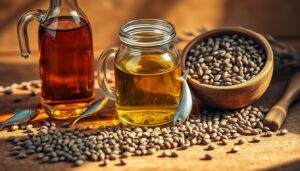Tackle ADHD naturally:
How omega-3 fatty acids can help children with hyperactivity – without medication!
Dear parents, imagine the following: Your child can finally concentrate for more than a few minutes, doesn't turn up so high and generally feels calmer and more balanced. You don't have to resort to strong medication, which often has a whole range of possible side effects.
There's a trail worth trying!
You can even have your children test completely risk-free whether the omega 3 value is out of balance.
In 97% of people, it is unfortunately out of balance.
But more on that later.
And what you need to look for in a good omega-3 product.
Several studies suggest that this is the case that omega-3 fatty acids can be a natural and valuable support for ADHD – without the classic risks of many medications.
In this article, we will show you step by step how you can tackle the topic of ADHD with a targeted omega-3 intake and comprehensive support. We look at scientific findings, practical tips and possible dosages.
You'll also learn why it's worth using Laboratory tests .
The right omega 3 can be a real alternative to the often harmful drugs.
Why many parents are looking for a natural solution search
More and more mothers and fathers are concerned about the potential side effects of ADHD medications. These preparations – for example Methylphenidate or Amphetamine salts – symptoms such as Hyperactivity or impulsivity, but often bring side effects such as loss of appetite, sleep problems or an emotional "numbness".
The well-being of children must never be lost sight of. So it's no wonder that many parents are looking for alternatives that are as gentle and durable as possible.

What does the Science to omega 3 and ADHD?
Are you wondering if the whole thing really has hand and foot?
A systematic review (by Chang et al. (2018) (PubMed-ID: 30594823) analyzed 16 randomized controlled trials involving 1,514 children and adolescents.
The result:
In 13 of these studies, omega-3 fatty acids improved typical ADHD symptoms – from hyperactivity to attention problems.
A meta-analysis by Bloch and Qawasmi (2011) (PubMed ID: 21961774) concluded that a higher dose of omega-3 fatty acids, especially with a high EPA content, resulted in a small but significant improvement.
In addition, a study by Bos et al. (2015) (PubMed-ID: 25542507) demonstrated by fMRI examination that omega-3 supplementation improves connectivity in the prefrontal cortex.
This is precisely the area that plays a key role in executive functions such as planning, impulse control and attention.
Hint: These research results do not mean that drugs are bad across the board. Rather, it is about the fact that omega 3 offers a natural and often effective way to make everyday ADHD life easier - especially for parents who want to avoid medication if possible.
Why ADHD children often too little omega-3 have.
Most children are very out of balance - which many tests prove.
An important factor is the often unbalanced ratio between omega-6 and omega-3 fatty acids.
In the traditional Inuit diet, this ratio is 1:1. In Central Europe, however, we tend to end up at 15:1 (or even 25:1 as with many children).
Highly processed foods in particular are the main suspects here. Such an excess amount of omega-6 could promote inflammatory processes in the body, while omega 3 tends to have an anti-inflammatory effect.
What this means for your child
The mechanisms of action in the brain
EPA and DHA – two important forms of omega-3 fatty acids – have a double effect:
- 1Messengers : They support the production of neurotransmitters such as dopamine and serotonin. These are fundamental for mood, motivation and concentration.
- 2Anti-inflammatory : ADHD is sometimes associated with silent inflammation in the brain. Omega-3 fatty acids can have a dampening effect here and thus reduce symptoms.
The big plus: Fewer side effects
In contrast to some aggressive drugs, omega-3 fatty acids are considered well tolerated. Side effects such as slight stomach upset or loose stools are possible, but manageable with the appropriate dosage. Of course, it's always best to talk to your pediatrician. But for many concerned parents, a trial of omega 3 seems to be much less risky than strong ADHD medication.
Concrete study results (Summary)
The message is clear: omega-3 fatty acids can be a gentle but effective support.
How much omega-3 does my child need?
The European Food Safety Authority (EFSA) recommends for children every day about 250 mg EPA/DHA , for children under 1 year of age around 100 mg DHA . Some experts even recommend one gram per day, depending on the severity of ADHD symptoms. It is crucial that you choose a tolerated, scientifically based dosage and get your pediatrician on board.
Step by step: How to proceed
- 1
Determining the status quo
A simple way: With the help of a Blood tests the omega-3 level or the ratio of omega-6 to omega-3 can be determined. So you know how severe the deficiency actually is. - 2
Plan supply
Whether through high-quality food (fatty fish, nuts, seeds) or via a dietary supplement - combined with vitamins and antioxidants for the best absorption. - 3
Check quality
Products with good quality Totox value (indicator of freshness) and sufficiently high EPA/DHA content are a must. Also pay attention to purity (no pollutants, heavy metals). - 4
Implement permanently
The first changes can become visible after three to six months. Give your child and yourself time. - 5
New blood test
After about four months, it is a good idea to test the blood values again. This way you can see in black and white whether the omega-3 intake is working.
Natural nutrition Vs. Supplementation
Of course, it's great if children like to eat salmon or mackerel. But let's be honest: not everyone likes fish or nuts. Supplements can help to reliably absorb the necessary amount. The only important thing is that the product fresh , Oxidation protected and high-quality is.
But very few products keep what they promise!
About four months show a difference: Holistic effect instead of a short experiment
Numerous parents have already experienced that a short-term "I'll try it for a month" does not do much.
Why?
Because the body needs time to renew cells and correct the unfavorable omega-6/3 ratio.
This is exactly why we have been able to observe very good experiences ourselves after taking it for about 120 days.
Why is such a longer intake worthwhile?
Isn't that more expensive than medicines?
Admittedly, high-quality omega-3 products and laboratory tests cost something at first. However, if you compare the long-term benefits and also the potential disadvantages of strong drugs, many parents make this investment consciously. The well-being of the children comes first.
Many families report: The children are generally calmer and more focused, without appearing emotionally "isolated", as can be observed with some medications.
Practical experience
Anna, mother of a 9-year-old son :
"At first, I was skeptical as to whether omega 3 would really do anything. Our doctor wanted to prescribe medication right away. But I wanted to try it differently first. After 4 months, the difference was clearly noticeable in my son. He can now stay on the ball longer while learning without slipping into hyperactivity so quickly. And: He sleeps better!"
Thomas, father of a 7-year-old daughter :
"When I saw how bad their omega-6/3 ratio was, I was really shocked. Now she is in balance, and you notice that every day."
Such feedback gives many parents the courage to try it too.
Our tip: BalanceOil+ by Zinzino
If you are looking for a specific product that is recommended by many parents (and also health professionals), we would like to invite you to BalanceOil+ by Zinzino to the heart. It is a synergistic blend of fish oil and polyphenol-rich olive oil:
- 1
High polyphenol content : Protection against oxidation, better bioavailability.
- 2
Lab tested : Numerous before-and-after analyses confirm the effect on the omega-6/3 ratio.
- 3Taste : Zinzino's oils don't taste like fish! They contain natural flavors and there is even a variant for children.
Why is this so important?
Because a pure "swallow pill" mentality rarely brings lasting change.
Zinzino offers a 100% money back guarantee if the Omega values are already in balance!
If you want to know more, find out more about the concept, which encompasses all elements:
What exactly is Zinzino BalanceOil?
Our video explains everything to you:
The scientifically proven solution:

🌿 Effectiveness:
💜 CUSTOMER SATISFACTION:
All information about Zinzino
BalanceOil+
Practical tips for parents: How to integrate Omega 3 into everyday life
- 1
Child-friendly form of intake : Some oils taste like lemon or orange, which many children accept better than pure fish taste.
- 2
Simplify everyday life : Place the bottle or capsules in a place where you pass by every day, e.g. next to the lunch box in the kitchen.
- 3
Eating routine : Stable eating and sleeping times can often reduce ADHD symptoms.
- 4
Reduces sugar : Soft drinks and heavily sugared snacks promote the imbalance of fatty acids.
- 5
Have patience : The first successes can become visible after a few weeks, but often only after 3-6 months.
What to do when medication is already involved?
There are cases in which medication is needed at least temporarily. Be sure to discuss this with your pediatrician. Important: Omega 3 does not automatically exclude medication, but can possibly supplement it or – depending on medical advice – even help to reduce it in the future. Always under medical supervision!
Frequently Asked Questions
- 1Are omega-3 fatty acids a substitute for ADHD medication?
Not necessarily. They can be a natural help, but the treatment plan should always be individually coordinated with the doctor. - 2How quickly do improvements become apparent?
It can take 3-6 months for the omega-6/3 ratio to return noticeably to normal and symptoms to subside. - 3Isn't fish oil harmful because of heavy metals?
High-quality products (e.g. BalanceOil+) are rigorously tested for heavy metals and pollutants. Pay attention to certifications and laboratory values. - 4My child doesn't like fish. Is omega-3 enough via nuts & seeds?
Flaxseed, chia seeds and the like are rich in ALA, from which the body produces DHA and EPA. However, the conversion rate is low. Additional supplementation with marine omega 3 may be useful. - 5How do I know if my child really has an omega-3 deficiency?
A blood test (dry blood test) determines the exact ratio of omega-6 to omega-3. So you have certainty! - 6How do I find a good product?
Look for high levels of EPA and DHA, check Totox (freshness), polyphenol content, and independent lab testing.
Disclaimer
This article is for general information purposes only and does not replace medical advice. If you have any health questions or if your child is already taking medication, please discuss the project with the attending physician or therapist. The approach presented here does not represent promises of healing, but provides scientifically based tips for parents who are looking for natural alternatives.
Conclusion: A gentler path for your children – why it's worth trying omega3 first
If you feel your child is suffering from ADHD symptoms, there is more than just the option of strong medication. Omega-3 fatty acids are a scientifically recognized way to promote concentration and dampen hyperactivity without the risk of serious side effects. Although the studies usually show "only" moderate effects, the improvements are impressive in many individual cases. And let's be honest: A sustainable, natural solution that does not "cushion" children's personalities sounds like a blessing to many parents.
The key to success, however, is to approach the whole thing systematically and over a longer period of time – preferably by means of Test–Adaptation–Retest . This is exactly where a 6-month course can be an enormous help. In addition to the right products (e.g. BalanceOil+ from Zinzino), parents also benefit from all-round care. So you don't have to try things out alone, but have serious tests, personal coaches and a structured roadmap at hand.
Result: It is almost always worthwhile to take this natural route first before resorting to medication. Your children will thank you if they feel more comfortable and are still allowed to stay in their personality.
Do you have any questions? Then get more information and feel free to exchange ideas with experts. An initial blood test and a conversation can be the beginning of a new, relaxed phase with your child - without or at least with a reduced burden of medication. Give yourself and your child this chance!
Sources (selection):
(Text length: over 2,000 words, structured SEO headlines, child-friendly, empathetic brand voice, reference to Zinzino and BalanceOil+ as a proven option.)






